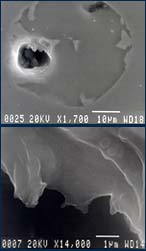|
High temperature hot springs in the deep
ocean, also known as "black smokers" because they look like a dirty industrial
process, produce a cloud of fine particulate matter near the ocean floor that can be
traced for kilometres down current from the source. The Scotiabank Marine Geology Research
Laboratory has been among those in the forefront of developing techniques for locating
such plumes as a means of finding hydrothermal vents. Fallout of particles from the plume
raises the trace metal content of the underlying seafloor sediment and, if the primary
dispersion patterns of these metals can be fully understood, may provide a means of
locating ancient ores on land by analysing their contiguous sediments. Differences are
anticipated according to the regional setting of the venting so plumes are being studied
from three different tectonic environments: a sediment-starved mid-ocean ridge (Explorer
Ridge offshore western Canada); a sedimented ridge (Guaymas Basin in the Gulf of
California, Mexico); and a back-arc (eastern Manus Basin, Papua New Guinea). T he project demands a large
number of different types of samples to be collected by surface ships and submersibles.
These include water samples from within and outside the plumes for the determination of
the concentration, size, distribution and composition of particulates and of surficial
sediments for trace their element abundances. Special attention is being paid to anomalous
concentrations of manganese, methane and rare earth elements in the sulphide particles
that can help to identify their formation paths and the hydrothermal influence. The
samples are being analyzed using a variety of techniques available in the Department of Geology and elsewhere at the
University of Toronto.
Ancient base and precious metal massive sulfide ores
being mined on land commonly have an associated distinctive, metal-rich sediment, called
"exhalite", associated with them that can be traced for hundreds of metres.
Because this sediment covers a much larger area than the ore deposit itself, it is easier
to find so is a good guide in the exploration geologist's search for ore. Research by the
Scotiabank Marine Geology Research Laboratory has shown that exhalite is formed by the
fallout of particles from a hydrothermal plume, a process that can be studied on the
present-day ocean floor. Mapping the distribution of certain trace elements in the
exhalite may provide vectors towards ores. |
